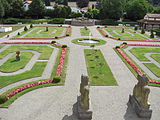Schwarzenacker Roman Museum
The Roman Museum Schwarzenacker is an archaeological open-air museum in Schwarzenacker , a district of Homburg in Saarland . The museum was built by the archaeologist Alfons Kolling , who also directed the archaeological excavations on site. The current director is Klaus Kell . The Gallo-Roman stage town, which was destroyed over 1,700 years ago and has over 2000 inhabitants, covers an area of around 25-30 hectares.
exhibition
The Roman Museum Schwarzenacker shows the remnants of a Roman vicus , which are of national importance and existed from the time around the birth of Christ until it was destroyed by the Alemanni in 275. The excavated floor plans of the buildings, various outdoor facilities, streets and canals can be viewed. The settlement has been partially rebuilt as an open-air museum.
In the neighboring noble house and in the rebuilt houses of the vicus, important finds from everyday life of the Roman population are exhibited, which come from the settlement itself or from the surrounding area. The so-called "house of the ophthalmologist" gives an impression of the life of wealthy Romans, with wall paintings and underfloor heating. The corner bar of the "Capitolinus" and the neighboring bakery have also been rebuilt. Replicas of life-size Roman equestrian statues, which were discovered in nearby Breitfurt in 1887, were set up in front of the entrance stairs of the Edelhaus. For many years, the originals stood in front of the entrance to the Palatinate History Museum in Speyer . However, they have since been dismantled and placed under one roof in the museum administration courtyard, as they were badly weathered due to environmental influences.
Not to scale replica of a pentagonal dodecahedron found near sacrificial shafts in 1980
Replica of a giant column of Jupiter that was flushed free during a storm in 1922 . The statue of Jupiter was missing a head and an arm; however, the insignia of scepter and lightning gag, which are important for the interpretation , were preserved.
Baroque garden in 2008
Hypocaust in the "house of the ophthalmologist"
Noble house
The noble house from the early 18th century (around 1725) was designed by Jonas Erikson Sundahl . In addition to the Roman finds, paintings by Johann Christian von Mannlich and other contemporary painters from the region are shown in the building. The noble house has a baroque-style garden that was laid out after the vicus was excavated. An exhibition on the top floor is currently (as of 2019) providing thematic information on the life and everyday life of Roman women from all social classes.
Other offers
During the main season, events for children and adults on a wide variety of topics take place in the Roman Museum in Schwarzenacker. This includes herbal seminars, insights into Roman cuisine, Roman handicrafts, workshops and themed tours. Roman days are also held every year, during which more vivid impressions of Roman life in the border area and a wide variety of demonstrations are offered through reenactment.
See also
- Roman excavations in Saarland
- the exhibition The Romans on the Moselle and Saar
- List of European open air museums
literature
- Alfons Kolling : The Roman city in Homburg-Schwarzenacker . Ed .: Foundation Roman Museum Homburg-Saarpfalz. Ermer Verlag, Homburg 1993, ISBN 3-924653-13-5 .
- Klaus Kell; Foundation Roman Museum Homburg-Schwarzenacker (Ed.): The Roman Open-Air Museum Homburg-Schwarzenacker. Ermer Verlag, Homburg 1996, ISBN 3-924653-20-8 .
- Klaus Kell: Trade, craft and trade: the vicus von Schwarzenacker. In: Vera Rupp , Heide Birley (Hrsg.): Country life in Roman Germany. Theiss, Stuttgart 2012, ISBN 978-3-8062-2573-0 , pp. 95-98.
Web links
- Website of the Roman Museum Schwarzenacker
- Literature about the Roman Museum Schwarzenacker in the Saarland Bibliography
- Exhibits from the Roman Museum on the Digicult website - museums in Saarland
- Information about the museum on the website of the city of Homburg
Individual evidence
- ↑ a b Marcel Schmitt: Roman Museum Schwarzenacker | Homburg, Saarland - Home. Accessed June 19, 2018 (German).
- ↑ Kolling: The Roman city in Homburg-Schwarzenacker , 1993.
Coordinates: 49 ° 16 ′ 58.2 " N , 7 ° 18 ′ 59.9" E







